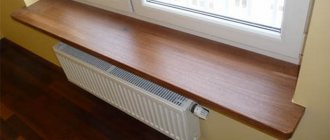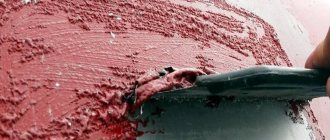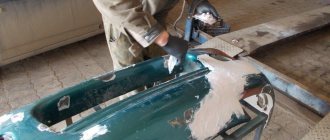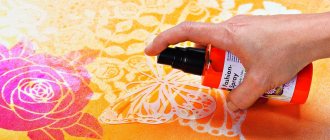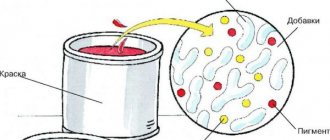For various reasons, a car owner may need to remove paint layers from the body or parts of the car. Most often, the need to clean the car surface arises if the vehicle is to be painted. But there are also situations when the appearance of a car is ruined because hooligans threw paint on the car. To remove the coating, not only various mechanical methods are used. A specially selected vehicle paint remover will simplify and speed up the entire process.
Methods for removing paintwork using specially designed means
The most common means used by car owners to remove paint are:
- Clay for cleaning car surfaces. It is usually sold as a kit, which, in addition to clay, includes a cleaning spray (it also acts as a lubricant), wax, polish and microporous cloth. This set of products usually works well with different types of paints and varnishes. After finishing work, use wax to rub the surface until it shines.
- Anti-scratch paste. To remove dyes, use a paste that can be found at any auto store. Apply it to a hard cloth with micropores, which is sold in the same section of the store.
- Gasoline, kerosene. These products will help wash away contaminants, but be careful - the substances are flammable and can seriously damage your car's existing finish.
- Brake pad cleaner. If the soap solution does not help, apply a special spray on a rag and wipe the body with it. Wash off the decals in sections and wipe the car dry after cleaning is complete.
Rating of paint removers
The first place is occupied by the Abro solvent. This liquid works well with oil paint, drying oil, various varnishes, epoxy resin, acrylic dyes and nitrocellulose. You can treat the entire surface of the car; it is suitable as a paint remover not only from metal, but also from the plastic of the car. Also suitable for household use as it does not contain alkalis.
Car owners often recommend DOCKER S4 to each other. Therefore, the substance takes an honorable second place. This is a universal solvent for almost all types of dyes used in mechanical engineering: oil-based, acrylic-based, and enamel. It will help to wash off paint, both from the entire surface of the car and locally, for example, washing off wheels.
Body wash takes third place for its efficiency. The substance is thick and practically does not spread from the car. Suitable for any color paint. It is used less often in everyday life, as it is very caustic.
MECHANICAL METHOD
The following can be used as abrasives:
sandpaper. Removal of paint is made possible thanks to abrasive grain (silicon carbide, aluminum oxide, aluminum zirconate, etc.), which is fixed with a bonding adhesive layer on a supporting base (paper, fabric, fiber, film)
When painting cars, great attention is paid to working with abrasive materials of this type. In our case, the most aggressive abrasives can be used to remove old paint
If we speak in the language of ISO-6344 sandpaper markings, then P60-P80 will suit you; cleaning disc and grinder. Suitable for small open areas. It is not recommended to remove paint on car body parts in this way, since the disc leaves deep grooves on the metal; cleaning flap wheels. Products for removing old varnish from furniture? They are sandpaper assembled like an accordion and installed in a special housing. The circle allows you to remove paint really quickly, but it also damages the metal quite a lot. Therefore, during body repair it is used only for rough processing of small areas; hard abrasives, which include special soft stones, as well as dense fabric circles soaked in special glue. Compared to a grinding disc on an angle grinder, abrasives of this type practically do not damage the metal; wire brushes mounted on a drill or screwdriver. You will not be able to quickly remove a thick layer of paint this way. But brushes of this type do a good job in hard-to-reach places, as well as removing corrosion.
Metal paint removers
Most often, metal paint remover is used in services specializing in auto repair. In addition, they can be used to clean other structures made from this material, such as the walls of garages and hangars. It is much easier to remove old paint from metal than from wood, since its layer is on the surface, clinging to microcracks in the material.
Many car manufacturers use acrylic as a base for paint compositions. Based on it they do:
- acrylic paints;
- metallic;
- nacre;
- acrylic lacquer.
Previously, alkyd was also common, but now it has been abandoned due to the difficulties of application and further operation.
There are several manufacturers that produce products that allow you to remove pigment from metal of various classes.
This product not only helps remove pigment, but also corrodes corrosion; most often it is used specifically to remove rust and rot from metal.
Body 700, “Prestige” - gel washes.
Both products are quite popular; they are applied to the surface of car parts with a brush; after drying, the material peels off the metal in layers and is easy to remove with a spatula.
Abro PR-600 - aerosol remover.
This product is applied to the surface with an aerosol. This is its main disadvantage, since part of the remover flies into the air, bypassing the metal, and can get on open areas of the skin, causing irritation. After drying, the material, just like after gel washes, can be removed with a simple spatula.
Kompozit SP-6 and Bosny are liquid removers.
They are applied in the same way as gel ones, using a brush. Due to their fluidity, they are not widely used, just like aerosol ones, since they can get on the skin or other unwanted areas.
When using materials to remove old paint from metal, you must use protective equipment: gloves and respirators. This is due to the fact that all these substances are quite harmful to human skin.
In services, these products are used to remove the old coating from a car because for complete peeling, the removers only need to interact with the surface for a few seconds. After which the car is treated with a degreaser for subsequent processing.
To improve the effect of paint removal work, it is better to carry it out in a warm, ventilated area; these conditions will speed up the removal process.
Types of paint removers for cars
To paint a car with high quality, you first need to get rid of the previous paintwork. In order to obtain a uniform effect, experts recommend using special products that are sold in almost every auto chemical store.
Car paint removers differ in the type of coating:
- universal;
- for “water-based emulsions”;
- quick removers for powder paints.
Each of these means has positive and negative sides, which we will consider below.
Remove old paint using a hair dryer (heat, thermal preparation)
There is another method of preparing for oil paint removal by heating the surface with a hair dryer. The hair dryer itself is similar to the usual hair dryer for drying hair, but has increased power. The cost of such a hair dryer is low, but it can be useful for other purposes. By the way, for those who have a fireplace in their home, it is simply necessary.
The operating principle of removing old paint using a hair dryer is simple. It is based on the fact that increasing temperature reduces the adhesion of paintwork materials and the painted surface. Simply put, the paint softens and is easily removed from the surface with a spatula.
Working with a hair dryer is slower, but much safer than working with a gas torch.
Working with a hairdryer is a rather labor-intensive process, since the hairdryer heats the surface being cleaned locally and the cleaning process does not progress so quickly.
Heat treatment for removing oil-based paints is ideal for wooden surfaces. Work is worse on concrete surfaces. It’s even worse on metal ones (the thicker the metal, the worse).
Heat treatment of the surface to be cleaned allows work to be carried out in a shorter time.
Just as when preparing the surface using chemical compounds, during thermal preparation it is necessary to provide fresh air in the room. This is forced draft or ventilation. Personal protective equipment is required.
Work carefully near flammable objects, plastic, plastic, glass.
In addition to a construction hair dryer, it is possible to use a thermal preparation of the painted surface for cleaning using a gas burner. This can be either manual or professional roofing, depending on the work area. But this preparation method is not recommended, as it is a fire hazard.
Regardless of the decision you make regarding the method of cleaning the surface from old oil paint, follow safety precautions.
How to remove old paint
In order to remove old paint, solvents are added to the removers. They can be harmful to health, so during work you must use personal protective equipment and follow safety rules.
The technology for cleaning a metal surface from old coating should be carried out in accordance with the instructions provided below.
- The metal is thoroughly cleaned of various contaminants.
- You can apply the remover with any tool. In this situation, it is necessary to take into account the dimensions of the part or structure. A brush is suitable for small products; a roller is best used for working on walls. If the structure is too large, then you should use a spray bottle.
- In order to save time on removing old paint, after the wash is applied, the surface is covered with plastic film. Thanks to this, the evaporation will not be as strong and the substance will act on the coating faster.
- Once the product is applied, you must wait for it to dry completely. The exact time is indicated by the manufacturer on the packaging of the substance.
- After this, you can begin to remove the paint with a spatula or a special wire brush.
- If the coating is not completely removed, then the previous steps must be repeated.
- A completely cleaned product must be treated with a special solvent. The manufacturer will indicate a suitable option in the containers with the remover.
Metal paint stripper is considered the fastest and most effective method of removing old coating.
This way you can save time and spend less effort preparing the surface for further processing.
Features of use
In order to remove paint from metal (in particular, from car body parts), three main methods are used - mechanical, thermal and chemical.
The disadvantages of the mechanical treatment method are the possible damage to applied areas that do not need to be treated, as well as the need for significant physical effort. The thermal method requires the presence of special equipment and the need to adhere to appropriate technology.
In home and garage conditions, the most preferable method is a chemical method of removing paint from the metal of a car body or other surface. Most popular paint removers work quickly and effectively, and are inexpensive. But which of them cope better with the task of removing paint and/or varnish are discussed in the rating below.
In order to remove old paint from metal in this way, you do not need a tool; the treatment is carried out by spraying from a spray gun or by smearing with a brush (when processing large surfaces, a roller is used). Another big advantage is that the product can be used on parts of any shape and material. However, it should be taken into account that you will have to work in a respirator, rubber gloves and in a ventilated place, and also do additional degreasing after washing is completed.
The essence of using paint removers is to apply the appropriate product to a previously cleaned surface, after which a chemical reaction occurs, which involves dissolving the old paint. In this case, only the paint coating is destroyed, and the metal (or other material) itself is not damaged, and, accordingly, is suitable for further painting, subject to pre-treatment with appropriate means.
As a rule, the effectiveness of paint destroyers depends not only on the effectiveness of the specific composition, but also on the age and quality of the paint itself. So, for example, the popular B-52 product has a limited shelf life. Any remover is applied at least two or three times, so if you didn’t succeed in cleaning the metal the first time, don’t rush to criticize the product.
Composition of paint removers
As a rule, the base of the product for removing paint from metal is an acid (it can be different, depending on the area of use, the intensity of the product, as well as the manufacturer itself; sulfuric or hydrochloric acid is often used). However, in most cases, acid poses a danger to human skin, and even more so to mucous surfaces (it is very dangerous to inhale the fumes). Accordingly, it is advisable to work with paint removers wearing personal protective equipment - rubber gloves and, possibly, a respirator. You must read the exact information about this in the instructions for the specific product BEFORE using it!
Paint removers are usually based on one of the following chemical compounds:
Organic solvent. These can be a variety of chemically active agents, for example, benzene, toluene, acetone, turpentine and similar compounds. They are excellent for removing epoxy coatings (resins), alkyd paints, and oil-based paints.
Acid. Usually sulfuric or hydrochloric acid is used. Removers based on them best dissolve acrylic paints, epoxy compounds, polyurethane, and neutralize pockets of corrosion. The disadvantage of such chemical compositions is that with prolonged exposure to the surface they can damage the metal. Accordingly, after application and treatment they must be neutralized with an alkaline solution.
Alkali. Typically this is sodium hydroxide (NaOH). Caustic soda-based metal paint removers are excellent for removing drying oil-based paints, as well as other decorative materials.
Please note that these are absolutely NOT suitable for treating aluminum surfaces, as they can damage them by entering into a chemical reaction.
When choosing a particular paint remover, you should always pay attention to its base, since this will not only allow you to choose the most effective product in a particular case, but also not harm the surface being treated. Therefore, always read what is written in the instructions!
What to remember when chemically removing paintwork
- ethylene paint is removed with ten percent sodium hydroxide;
- Using a solution of hydrochloric acid (25 percent), water (50 percent) and white clay (25 percent), you can quickly remove almost any paint. True, then it is necessary to use quicklime for neutralization;
- acid-resistant clay (50 percent), sodium hydroxide (15 percent) and water (35 percent) form a good paint remover up to 5 mm thick. The resulting substance just needs to be applied to the surface and left for 30 minutes;
- the combination of caustic soda, Sovelite and water allows you to clean paintwork right down to the metal;
- acrylic enamel is best removed using solvent N648;
- a mixture of 10 percent paraffin, 10 percent wood alcohol and 80 percent benzene acts very slowly (as much as 3 hours), but effectively;
- oil paint can be removed from metal surfaces using xyrene solvents;
- A 30% solution of caustic soda can be applied to a metal surface and then washed off after a couple of hours. The method is quite effective, but requires a lot of time.
Removing layers of paint from a car body - cheap methods
You can prepare a completely effective and high-quality paint remover with your own hands. For this you will need good caustic soda and some water. A solution containing 15-20 percent of this material can remove the paint layer by layer. But to work with such a liquid, personal safety must be observed. Soda can quickly corrode not only enamel, but also skin. Also, when looking for an idea on how to remove paint, you can use the washing method:
- get some fine-grained sandpaper 1500-2000 and a bottle with a pierced cap for supplying water;
- using a bottle, apply a small stream of water to the area that needs to be cleaned of car enamel;
- use sandpaper to remove the layer little by little (if you need to strip down to metal or plastic, first use coarse-grained material);
- then reduce the grain of the paper to get the most even base for further painting;
- This layer removal does not harm the surface, allows you to adjust the degree of material removal and gives an excellent result.
No chemicals are used. The only liquid involved is water, but in this case there will be a lot of manual work. This kind of washing of even one small part can take a lot of time, but the layers will be removed exactly to the extent that you need. After washing down to the primer, you will need to lubricate the metal parts with a degreasing solvent, and you can paint.
Other paint removal methods
Below are several methods for removing paint from a car using improvised means:
- Soap solution. To create it, you need to fill a bucket of warm or hot water, and then add car shampoo, dish detergent or liquid hand soap. Armed with a piece of cloth or a dish sponge, try to wash the paintwork material. You may need a solvent during your work. However, it is worth remembering that some types of paints in spray cans are very easily washed off with ordinary soap and water. This technique is also useful if the dye has not yet had time to dry in the sun. In this case, the speed of rinsing is of great importance.
- Nail polish remover. Use any product that does not contain acetone. A high-quality product can remove various types of paint and varnish materials, including paint from glass or bumpers. When working, use a terry cloth. This technique helps many drivers. After completing the work, you need to thoroughly rinse the area where the detergent was applied.
- Acetone. Along with chemical solvent, suitable for many types of paint. However, it is worth considering that due to its aggressiveness, it can damage the existing layer of paintwork on your car. To determine if this method is right for you, apply a small amount of acetone to an inconspicuous damaged area of the car or rub some of the damage with a rag soaked in the product. After this, quickly remove the acetone using a dry and clean piece of cloth. Observe if changes occur. If you see that your vehicle's paintwork is beginning to fade or wash away in addition to removing paint, do not continue. If there is no effect, try increasing the amount of acetone or scraping off dye stains from the surface of the car. Cleaning can occur in several stages and require mechanical movements.
- Solvent. The most popular among car enthusiasts is white spirit. It can cope with acrylic, water-based and other types of paints and varnishes without spoiling the appearance of the vehicle.
- Contacting an insurance company or service station. If the above methods do not help, you should contact a painting specialist to avoid damage to your car. If your vehicle is insured, you don't have to take any action—just call your insurance agent. If the car insurance is comprehensive, it should contain a clause providing for compensation for damage due to vandalism. In order to be sure that the insurance compensation will be paid, you need to check whether the payment is greater than the deductible.
Chemical method of removing paint from a body
The chemical method of removing paint involves applying a special composition to the car body, which contains solvents that can soften the paint. The applied reagents soften the enamel, making it easy to remove with a spatula, scraper or other tools.
A means for chemically removing paint from a body can be:
- Acidic. This product contains aggressive components that, if they come into contact with the paint, corrode it;
- Alkaline. The principle of operation of such products is close to acid-based options;
- Organic. Most often these are acetone or turpentine based products that can “soak” the hard paint film.
Please note: In rare cases, when specialized products do not allow you to remove paint from a car body, formic or phosphoric acid is used. The process of chemically removing paint from a car body is performed in the following sequence:
The process of chemically removing paint from a car body is performed in the following sequence:
The first step is to take care of personal safety equipment - put on a respirator, gloves, make sure that the skin is securely hidden under clothing; Next, all plastic and rubber elements are removed from the area that will be treated with the chemical composition.
This is important to do, since aggressive compounds can damage plastic; Using a brush, the product is applied to the surface from which paint needs to be removed; After the time indicated on the packaging of the product used, the paint will become wet and can be removed with a spatula; If some areas of the body are not completely cleared of paint after the first time, reapply the composition; The final stage is washing the body with water. It is worth noting that the chemical method of removing paint from a car body is rarely used for cleaning large parts
It is usually used when you need to remove paint from hard to reach areas
It is worth noting that the chemical method of removing paint from a car body is rarely used to clean large parts. It is usually used when you need to remove paint from hard to reach areas.
Special paint removers – Abro or Body 700?
At your auto store, you can find liquids specifically designed to remove layers of paint from your car. Washing helps to clean the surface down to metal or remove the required number of layers of paint material. The Body company offers a fairly effective option - Body 700 liquid. Removing paint from a car will happen in a matter of minutes, and you won’t have to work for it. But we also suggest looking at Abro products with the following features:
- the product works more efficiently and quickly, cleans all types of paints and varnishes in a matter of seconds;
- the aerosol base makes the material the safest and easiest to use for your tasks;
- It is enough to apply the liquid to the surface, then simply wipe off the resulting layer with a napkin;
- carry out the procedure several times, and the result will be simply amazing - the surface will be cleaned;
- The instructions contain precautions, but in most cases there are no problems in operation.
This wash works great, even if you need to remove the factory paint layers. The product meets high quality standards. If you are going to purchase such a specialized material, then Abro paint remover is the recommended option. Many specialists in the painting business use just such products to perform the necessary tasks. But make sure that you buy the original product, there are many fake liquids with low quality.
Metal on disks - we wash the paint professionally
Wheels often need to be updated when changing or freshening up the appearance of your car. This is what wears out quite quickly, so you constantly need to take care of this element of the car. In this case, washing off the old paint is necessary, since otherwise it will not be possible to carry out the normal application of new decorative materials. You need to wash it off with special means, since rinsing and caustic soda will not help here.
The problem is that the surface of the disk has many curves and small details that are extremely difficult to process in the required mode. For this reason, you need to perform high-quality treatment with a special liquid. You can use the products presented above or choose other brands. It is only important to read the instructions and understand that this particular option is suitable for your task of processing car wheels.
Preparing for work
Before removing old paint from metal, you need to take care of safety precautions when performing work. For example, if you use a mechanical method for cleaning surfaces from paint, then you should use a respirator.
When processing metal with tools such as sandpaper, a drill or an angle grinder with a wire brush, fine dust rises into the air. To avoid this, you should wet the work surface with cold water; it will prevent small particles from flying around the room. A spray bottle is best for this.
Also, all metal products differ in their dimensions and properties. For convenience, large objects of complex shape, such as old radiators, should be dismantled before starting work, as well as intricate small parts of prefabricated structures.
It is also worth considering that some products are quite brittle and fragile and require careful handling, while others do not care about rougher cleaning methods. Therefore, before starting the process, it is worth choosing the right cleaning method.
Removing paint materials from plastic surfaces
Among automotive plastic parts in the painting process, it is worth highlighting two options. These are interior parts and parts of the exterior of the car. The bumper most often has the same coating as the metal parts of the car. The inner plastic is painted in a different type of painting material. The question arises as to how to remove paint on a plastic part. There are several options for action in this case:
- If the quality of the coating is poor, it can be knocked off using high pressure in the washer. Using Karcher or other equipment, you can knock down the paintwork by placing the water flow at an angle.
- Removal is possible using the same remover. But in this case, the liquid must be applied carefully. You should check the manufacturer's directions to see if there are any restrictions for use on plastic.
- Mechanical removal means can also be used (spatulas, brushes and pumice stones), but in this case the surface of the plastic can be damaged. It is better to use more delicate methods.
- You can use the washing procedure without bringing it to the base. That is, your bumper or interior panel will receive a ready-made base for applying paint materials.
This procedure is more subtle than removing paint from metal, so it must be done carefully. If the surface of the plastic is damaged, the part will have to be leveled, which will bring completely different costs and time. If you need to completely remove the paint layer from a product, it is better to do it yourself. Even when ordering professional painting of an element in a chamber, you will receive significant savings on the preparatory processes.
Features of removing paint from plastic
To remove paint from plastic, you should know the removal features. This will help avoid possible troubles and save time.
When removing paint, adhere to the following rules:
- a fresh blot is faster and easier to remove than an old one;
- fresh stains are removed using water and any detergent;
- old contamination is pre-prepared (treat the surface with a solvent) and then washed off;
- When working with electrical devices, adhere to safety precautions;
- Use a removal method depending on the type of paint.
Important! To prevent the plastic from being accidentally contaminated during painting, use construction tape. It is used to paste over plastic products.
Advantages and disadvantages of the chemical method
This method is attractive due to its simplicity of execution. It does not require physical effort to achieve results. But it requires patience, especially when working with slow-acting agents. And the range of products allows you to choose an effective composition for any type of paint.
Among the disadvantages of the method is the need to spend money on products from the store. Or time to prepare folk remedies. In addition, the chemical components are toxic. Therefore, working with them is associated with health risks. Especially in closed spaces. Therefore, when chemically cleaning metal, it is necessary to observe all safety measures and not neglect gloves and respirators.
Features of surface cleaning using chemicals.
If you have a penchant for chemical experiments, you can make paint stripper in your garage. The following methods are widely used among people:
- For ethylene paint, use sodium hydroxide 10% (regular caustic soda);
- A solution of hydrochloric acid (25%) with water (50%) and white clay (25%) dissolves paint perfectly, but then you need to use quicklime to neutralize it;
- A composition of acid-resistant clay (50%), sodium hydroxide (15%) and water copes with a layer of 5 millimeters in about half an hour;
- Caustic soda with sovelite and water will successfully clean the surface of your car down to the metal;
- Paraffin (10%), wood alcohol (10%) and benzene (80%) will destroy paint in 3 hours;
- Solvent N648 “specializes” in acrylic enamel;
- Solvents containing xylor will remove oil paint from iron.
- Many craftsmen use caustic soda the old fashioned way, apply a 30% solution to the metal surface, leave it for several hours, and then wash it off. This method is not bad, but it takes a lot of time.
Now in stores there is a wide selection of chemicals that allow you to clean the surface of your car much faster. Specialized liquids soften the paint in a few minutes and allow painting work to be carried out much faster.
By professional means
Among the recommended means for removing old oil paint from metal is called “Constant”. The gray-white composition contains organic solvents, disintegrants and thickeners. According to technical information:
- consumption is 150-170 per square meter, when removing one layer of paint;
- the content of non-volatile components can reach 10%;
- evaporation reaches 6% at a temperature of 20 degrees Celsius;
- It may take 20 minutes to wash off one layer;
- If the solvent remains on the surface longer, there is a risk of corrosion.
The composition is sold ready for use. However, its expiration date remains valid if the product is in a sealed package and is not exposed to direct sunlight or within the range of heating devices. Neomid and Dufa Abbeiser are considered analogues of “Constant”.
Types of paint removers
Paint removers are available in a wide variety on the construction market. Manufacturers offer various formulations that can cope with certain tasks. Therefore, the choice must be made with knowledge of the options that are available. Then it will be possible to choose the best option, and the surface will not be damaged and further painting will be possible without problems.
There are general divisions that make choosing easier. The products are intended for specific types of paints, and are also divided according to the form of release; the method of use differs here.
Paint removers are available in a wide variety on the construction market.
Depending on the base
The division according to the type of base does not require explanation; choose a product that is suitable for the paint used previously for painting. The following types are distinguished:
- Substances for removing water-based and oil-based paints;
- Special compositions for working with metal products;
- Express washes. As the name suggests, they help to clean very quickly;
- Universal, which can be used for many types of coatings. A convenient option if you don’t know what paint was used previously;
- For powder paints and varnishes.
By form (liquids, gels, powders and aerosols)
This qualification affects the processing method and is selected based on the preferences of the master. Manufacturers produce the following types of washes described below:
- In cans, application does not require special skills, application is easy, you just need to maintain a distance of 200-300 millimeters from the product to which the product will be applied;
- Liquids can be used when working with horizontal surfaces; it is also possible to completely immerse parts in liquid. You can prepare similar options yourself; the process will be described at the end of the article;
- Gels and pastes (powders). They are convenient to work with when you need to apply the product to a vertical surface; they will not flow down the surface and can penetrate deep into the base to qualitatively soften the paintwork material. They are suitable for removing paint, for example, from a fence; you will not need to remove elements to remove old paint from them. Among the gels, Prestige, a Russian manufacturer, stands out.
All substances have different prices, so it is possible to choose the option that will be available.
Overview of the main methods
Without removing the paint, it is impossible to properly apply a new coat of paint. There are several ways to get started with this work:
- Perform mechanical cleaning. This option makes sense to use in cases where the work needs to be done urgently, without worrying about the condition of the surface from which the paint is being cleaned. For this purpose, use mechanical spatulas or a grinder with a grinding attachment.
- Sometimes a thermal option is used. This involves heating the metal surface to such an extent as to facilitate removal. This option is very labor-intensive and ineffective.
- Use of specialized chemicals. The use of special cleaning removers allows for high-quality cleaning without damaging the surface. There are many types of such chemicals, allowing you to choose the most effective in each specific case.
An aerosol can be used for cleaning. Source i.ytimg.com
When removing old paint, choose the most suitable options in a particular case. Chemical cleaning agents show higher efficiency.
Folk remedies
The oil coating can also be removed:
- A mixture of turpentine and ammonia in a ratio of 2:1. It will take about an hour for the paint to dissolve.
- A solution of quicklime and potash (70/30). The composition is diluted with water until a viscous consistency is formed. It will take 12 hours for the paint to dissolve.
- A mixture of chalk and lime paste in a 1:1 ratio. The composition is supplemented with 20% caustic soda, which gives it a paste-like appearance. The resulting product is applied to the paint in a layer of 2 millimeters. When using this method, mechanical cleaning can begin after an hour or an hour and a half.
Therefore, you can prepare effective remedies yourself. The choice is influenced by the availability of the necessary components, as well as the urgency of the work.

